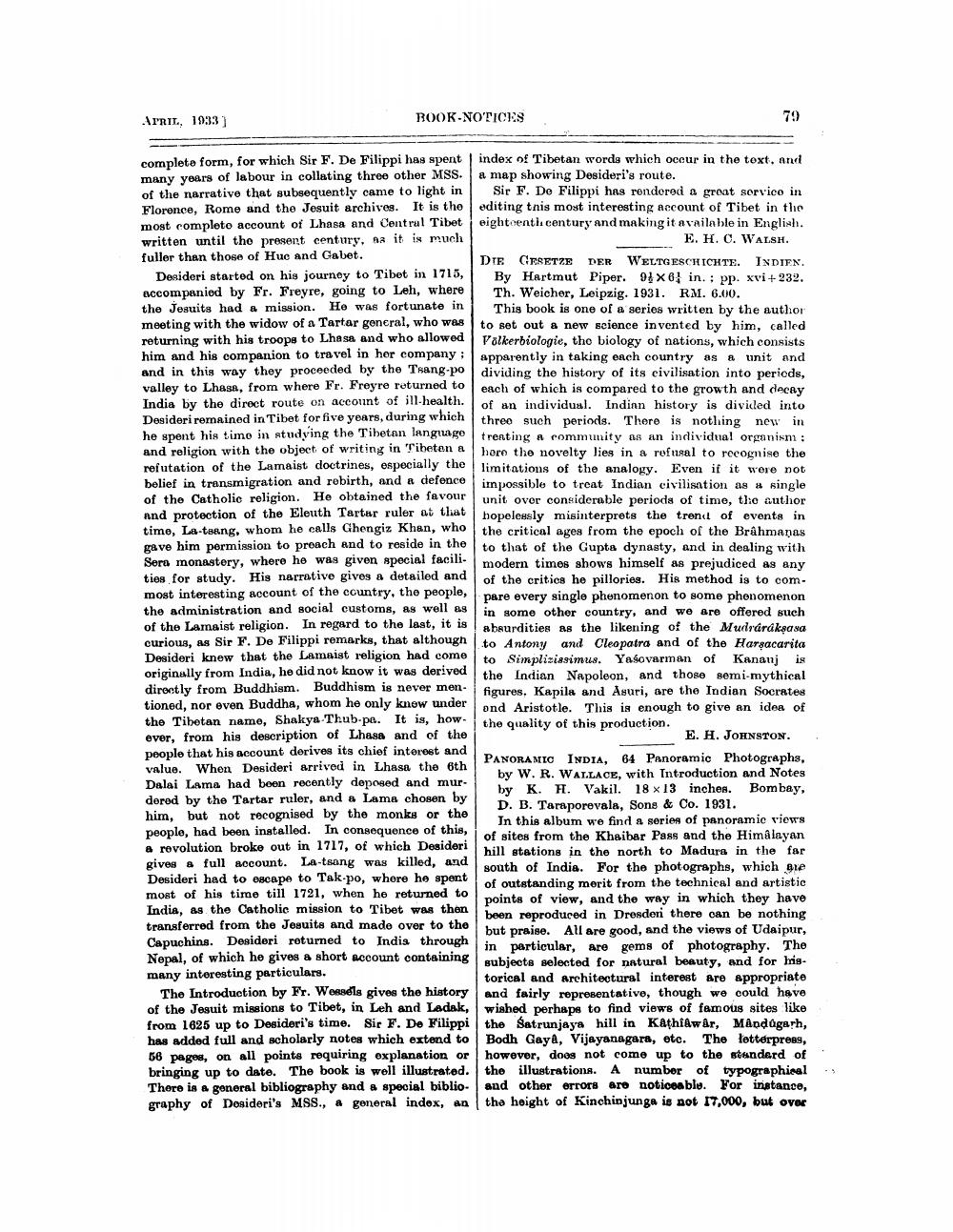________________
BOOK-NOTICES
APRIL, 1933]
complete form, for which Sir F. De Filippi has spent many years of labour in collating three other MSS. of the narrative that subsequently came to light in Florence, Rome and the Jesuit archives. It is the most completo account of Lhasa and Central Tibet written until the present century, as it is much fuller than those of Hue and Gabet.
Desideri started on his journey to Tibet in 1715, accompanied by Fr. Freyre, going to Leh, where the Jesuits had a mission. He was fortunate in meeting with the widow of a Tartar general, who was returning with his troops to Lhasa and who allowed him and his companion to travel in her company and in this way they proceeded by the Tsang-po valley to Lhasa, from where Fr. Freyre returned to India by the direct route on account of ill-health. Desideri remained in Tibet for five years, during which he spent his time in studying the Tibetan language and religion with the object of writing in Tibeten a refutation of the Lamaist doctrines, especially the belief in transmigration and rebirth, and a defence of the Catholic religion. He obtained the favour and protection of the Eleuth Tartar ruler at that time, La-tsang, whom he calls Ghengiz Khan, who gave him permission to preach and to reside in the Sera monastery, where he was given special facilities for study. His narrative gives a detailed and most interesting account of the country, the people, the administration and social customs, as well as of the Lamaist religion. In regard to the last, it is curious, as Sir F. De Filippi remarks, that although Desideri knew that the Lamaist religion had come originally from India, he did not know it was derived directly from Buddhism. Buddhism is never mentioned, nor even Buddha, whom he only knew under the Tibetan name, Shakya Thub-pa. It is, however, from his description of Lhasa and of the people that his account derives its chief interest and value. When Desideri arrived in Lhasa the 6th Dalai Lama had been recently deposed and murdered by the Tartar ruler, and a Lama chosen by him, but not recognised by the monks or the people, had been installed. In consequence of this, a revolution broke out in 1717, of which Desideri gives a full account. La-tsang was killed, and Desideri had to escape to Tak-po, where he spent most of his time till 1721, when he returned to India, as the Catholic mission to Tibet was then transferred from the Jesuits and made over to the Capuchins. Desideri returned to India through Nepal, of which he gives a short account containing many interesting particulars.
79
|
index of Tibetan words which occur in the text, and a map showing Desideri's route.
The Introduction by Fr. Wessels gives the history of the Jesuit missions to Tibet, in Leh and Ladak, from 1625 up to Desideri's time. Sir F. De Filippi has added full and scholarly notes which extend to 56 pages, on all points requiring explanation or bringing up to date. The book is well illustrated. There is a general bibliography and a special bibliography of Desideri's MSS., a general index, an
Sir F. De Filippi has rendered a great service in editing this most interesting account of Tibet in the eighteenth century and making it available in English.
E. H. C. WALSH.
DIE GESETZE DER
WELTGESCHICHTE. INDIEN.
By Hartmut Piper. 9x6 in.; pp. xvi+232. Th. Weicher, Leipzig. 1931. RM. 6.00. This book is one of a series written by the author to set out a new science invented by him, called Völkerbiologie, the biology of nations, which consists apparently in taking each country as a unit and dividing the history of its civilisation into periods, each of which is compared to the growth and decay of an individual. Indian history is divided into three such periods. There is nothing new in treating a community as an individual organism: here the novelty lies in a refusal to recognise the limitations of the analogy. Even if it were not impossible to treat Indian civilisation as a single unit over considerable periods of time, the author hopelessly misinterprets the trend of events in the critical ages from the epoch of the Brâhmaņas to that of the Gupta dynasty, and in dealing with modern times shows himself as prejudiced as any of the critics he pillories. His method is to compare every single phenomenon to some phenomenon in some other country, and we are offered such. absurdities as the likening of the Mudrárākṣasa to Antony and Cleopatra and of the Harṣacarita to Simplizissimus. Yasovarman of Kanauj is the Indian Napoleon, and those semi-mythical figures, Kapila and Asuri, are the Indian Socrates and Aristotle. This is enough to give an idea of the quality of this production.
E. H. JOHNSTON. PANORAMIC INDIA, 64 Panoramic Photographs, by W. R. WALLACE, with Introduction and Notes by K. H. Vakil. 18 x 13 inches. Bombay, D. B. Taraporevala, Sons & Co. 1931.
In this album we find a series of panoramic views of sites from the Khaibar Pass and the Himalayan hill stations in the north to Madura in the far south of India. For the photographs, which gre of outstanding merit from the technical and artistic points of view, and the way in which they have been reproduced in Dresden there can be nothing but praise. All are good, and the views of Udaipur, in particular, are gems of photography. The subjects selected for natural beauty, and for historical and architectural interest are appropriate and fairly representative, though we could have wished perhaps to find views of famous sites like the Satrunjaya hill in Kathiawâr, Mandugarh, Bodh Gaya, Vijayanagara, etc. The letterpress, however, does not come up to the standard of the illustrations. A number of typographisal and other errors are noticeable. For instance, the height of Kinchinjunga is not 17,000, but over




